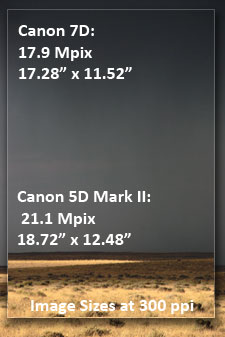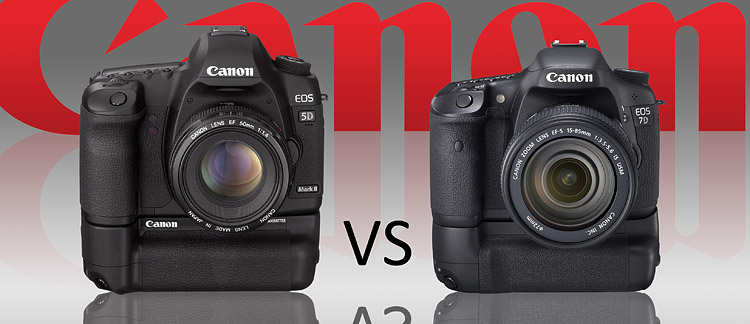The Differences That Matter
The first difference worth mentioning, of course, is the price tag…. about $900 difference, if the current prices listed are any indication (7D at about $1599 at Amazon and the 5D Mark II at about $1,084.95). Since we’re looking at a couple of cameras that have the build quality for professional use, with magnesium alloy bodies, full HD video capabilities, top notch processors, and some of the most advanced CMOS sensors around, we can expect professional quality results from either camera. In fact, comparing the columns of features for the two cameras reveals that the vast majority of them are identical. Something must justify the price difference, though.
Most obviously is the CMOS sensor difference, the 5Dii being a 21M pixel, full frame sensor, and the 7D being an APS-C size holding about 18Megapixels. The 7D has dual Digic4 processors, whereas the 5Dii has only one. Probably as a result of this, the new arrival boasts burst speeds about twice as fast as the 5D. There are many other minor differences (and perhaps a few significant ones), but I think that these are the most important to consider up front.
Pixels and Sensor Size

If all other things were equal, the pixel count between the 7D and 5D Mark II would not be a significant factor in choosing one camera over the other. I’ve illustrated the file size difference (left) with images scaled to the dimensions of each camera’s output, but just by looking at the numbers we can get a pretty good idea of how things would stand. The difference is about an inch in on each axis… not a big deal.
But of course, it’s not quite that simple. Since the 7D’s sensor is considerably smaller than that of the 5D, its receptors are also smaller and more densely packed. Traditionally, dense receptors have produced more digital noise than their larger counterparts, especially during long exposures which generate more heat. Canon has done a good job of controlling digital noise with their efficient sensors and processing in the past, and although the 7D produces relatively little digital noise, it still falls a bit short of the performance of the 5D Mark II, which has been so highly praised for its ability to produce low noise images in nearly any lighting situation. A variety of ISO comparisons are available across the internet, including mine, here, if you’d like to see how subtle the difference is.
Much more importantly, though, is how the sensor size effects resolution. Many photographers have already noted that the receptor density of the Canon 50D has already matched (in resolution) what we used to achieve with slow 35mm film. Indeed, on the 50D, the sensor density is roughly 213 pixels per millimeter, a density that would produce a 39 megapixel image on full frame sensor such as the 5D series. The 7D takes this development even further, with around 233 pixels per millimeter, at which resolution a full frame sensor would produce a 46.7 megapixel image.
Why do these numbers matter? Because at this resolution, the image quality is frequently limited by the lens rather than the sensor. Even at the 15 megapixels of the Canon 50D (and certainly at the 18 megapixels of the 7D) the sensor will usually have the resolution to capture all of the detail that the lens can resolve, including the flaws in the lens performance such as chromatic aberration, corner softness, diffraction, and any manufacturing flaws; adding additional megapixels will only serve to increase file size, not detail. The same thing can be achieved with good up-sampling software, such as onOne’s Genuine Fractals. Furthermore, since the sensor is smaller than a full frame dSLR’s, the image will have to be enlarged proportionately more to achieve the same size print… which will also enlarge the flaws from the lens. An excellent article about this effect in the Canon 50D with photographic examples can be found on the Luminous Landscape.
In order to reap any benefit from the increased resolution of the 7D’s sensor, photographers will need to use the best lenses and their best technique. Some of Canon’s “L” lenses and a few lenses from the Pro lines of other manufacturers (such as Sigma, Tokina, and Tamron) will produce quality results, but even those lenses will need to be used properly. The photographer will need to determine the optimum aperture for each lens (at which it produces the highest resolution across the full frame) before being limited by diffraction by the aperture leaves. Furthermore, tripods and remote (or timed) release will be crucial.
Another important difference due to sensor size is the depth-of-field (DOF). In general terms, the larger the sensor or film, the shallower the depth of field. The difference in DOF between a Canon APS-C sensor and a full-frame is slightly more than 1 f-stop (ie; if a 5D Mark II is using a 200mm lens and a 7D is using a 125mm to get an equivalent field of view, the 7D has to shoot at f/1.8 to get DOF as shallow as the 5D has at f/2.8). Depending what you shoot, having greater depth of field can either be a drawback or a benefit: it can be great for photographers who want as much in focus as possible, a nuisance for photographers wishing to separate their subject from a blurry background.
Who Should Buy the Canon 7D, then?
From the previous section, you might be under the impression that I would not recommend the 7D, but that’s not the case. The issue depends entirely on the photographer’s shooting style. The speed of the 7D, coupled with its new AF system and large, bright viewfinder, make it an excellent choice for sports photographers and other journalists for whom the increased (1.6x) magnification are a benefit. Wedding photojournalists may be included in this group. These photographers, who regularly hand-hold their shots and reproduce them in forums that do not necessitate the highest resolution, are not effected by the lens resolution limits.
Art and Landscape photographers, on the other hand, may benefit from the better overall resolution of the 5D Mark II. Since these photographers typically shoot for the highest resolution, with heavy tripods and excellent technique, they will notice the better image quality from the 5D, but also will get the most out of a 7D if they happen to use one.
| The 7D is the best choice if you… | The 5D Mark II is the best choice if you… |
|---|---|
| shoot lots of action: sports, journalism, events. | shoot landscapes, macros, or fine detail work. |
| don’t mind getting extra depth of field. | prefer shallower depth of field and traditional perspective. |
| frequently shoot telephoto. | use full frame, wide angle lenses. |
| usually shoot hand-held shots. | usually use a tripod or studio strobes. |
| expect to buy the best quality lenses and use them at their optimal settings to get the most from you sensor. | use a wide range of full frame lenses. |
| believe that speed, responsiveness, and good resolution are most important to you. | believe that excellent resolution/best image quality and good speed are most important to you. |
Video Features
The 5D Mark II is ultimately better for video if you’re willing to put some work into it, by doing things like using firmware side-cars (eg, Magic Lantern), upgrading to the most recent Canon firmware, and using some less than user-friendly video controls along with film industry hardware add-ons.
The 7D is better for the casual video user due to its ease-of-use. It has a dedicated video record button, for example, and the same resolutions and frame rates as the 5D Mk II.
If you’re interested in the video capabilities of the 5D Mark II and the 7D (and Rebel T2i), please follow this link to my related article on the subject: Video Features of the Canon EOS 5D Mark II and Canon EOS 7D.
Please Comment! I’m always interested to hear whether my readers find the articles interesting, useless, or otherwise… and more importantly, I’d like to hear your opinions and additional information, even if it’s just a tidbit. THANKS!




